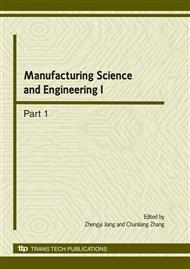p.1087
p.1091
p.1097
p.1104
p.1109
p.1116
p.1120
p.1126
p.1130
Equal Channel Angular Pressing and Torsion of Pure Al Powder in Tubes
Abstract:
In this work, a new severe plastic deformation technique for preparing bulk fine-grained materials has been developed to achieve higher plasticity of powder materials. This novel technique, named Equal Channel Angular Pressing and Torsion (ECAPT), combines two severe plastic deformation methods: equal channel angular pressing and twist extrusion. With the designed ECAPT set-up, pure Al powder particles were successfully consolidated into full dense bulk material with fine grains at a lower deformation temperature (200°C) by Powder in Tubes-Equal Channel Angular Pressing and Torsion (PITS-ECAPT). After two passes of PITS-ECAPT, the microstructures at X, Y and Z planes of each sample were all sheared and elongated along a certain direction with fine banded structures; the grains were greatly squashed and refined with an average grain size of ~ 11.90µm; the deformed sample reached the full density; the micro-hardness and yield strength achieved 49.9kg/mm2 and 155Mpa respectively, which were significantly higher than those of as-cast annealed pure Al and pure Al powder sintered materials.
Info:
Periodical:
Pages:
1109-1115
Citation:
Online since:
March 2010
Authors:
Price:
Сopyright:
© 2010 Trans Tech Publications Ltd. All Rights Reserved
Share:
Citation:


